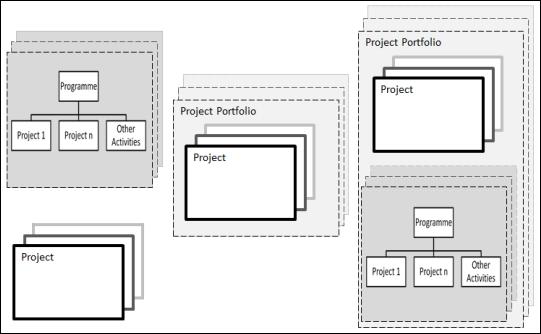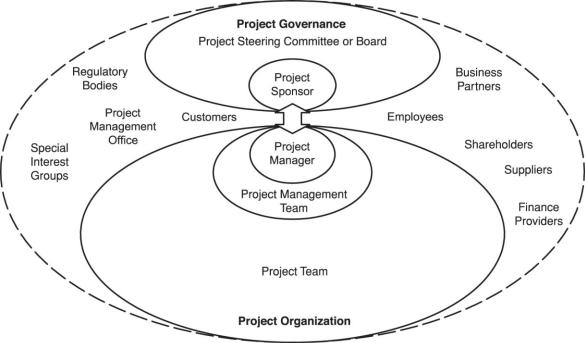
- •Introduction
- •1 Scope
- •2 Terms and definitions
- •3 Project management concepts
- •3.1 General
- •3.2 Project
- •3.3 Project management
- •3.4 Organizational strategy and projects
- •3.4.1 Organizational strategy
- •3.4.2 Opportunity evaluation and project initiation
- •3.4.3 Benefits realisation
- •3.5 Project environment
- •3.5.1 General
- •3.5.2 Factors outside the organizational boundary
- •3.5.3 Factors inside the organizational boundary
- •3.5.3.1 General
- •3.5.3.2 Project portfolio management
- •3.5.3.3 Programme management
- •3.6 Project governance
- •3.7 Projects and operations
- •3.8 Stakeholders and project organization
- •3.9 Competencies of project personnel
- •3.10 Project life cycle
- •3.11 Project constraints
- •3.12 Relationship between project management concepts and processes
- •4 Project management processes
- •4.1 Project management process application
- •4.2 Process groups and subject groups
- •4.2.1 General
- •4.2.2 Process groups
- •4.2.2.1 General
- •4.2.2.2 Initiating process group
- •4.2.2.3 Planning process group
- •4.2.2.4 Implementing process group
- •4.2.2.5 Controlling process group
- •4.2.2.6 Closing process group
- •4.2.2.7 Project management process group interrelationships and interactions
- •4.2.3 Subject groups
- •4.2.3.1 General
- •4.2.3.2 Integration
- •4.2.3.3 Stakeholder
- •4.2.3.4 Scope
- •4.2.3.5 Resource
- •4.2.3.6 Time
- •4.2.3.7 Cost
- •4.2.3.8 Risk
- •4.2.3.9 Quality
- •4.2.3.10 Procurement
- •4.2.3.11 Communication
- •4.3 Processes
- •4.3.1 General
- •4.3.2 Develop project charter
- •4.3.3 Develop project plans
- •4.3.4 Direct project work
- •4.3.5 Control project work
- •4.3.6 Control changes
- •4.3.7 Close project phase or project
- •4.3.8 Collect lessons learned
- •4.3.9 Identify stakeholders
- •4.3.10 Manage stakeholders
- •4.3.11 Define scope
- •4.3.12 Create work breakdown structure
- •4.3.13 Define activities
- •4.3.14 Control scope
- •4.3.15 Establish project team
- •4.3.16 Estimate resources
- •4.3.17 Define project organization
- •4.3.18 Develop project team
- •4.3.19 Control resources
- •4.3.20 Manage project team
- •4.3.21 Sequence activities
- •4.3.22 Estimate activity durations
- •4.3.23 Develop schedule
- •4.3.24 Control schedule
- •4.3.25 Estimate costs
- •4.3.26 Develop budget
- •4.3.27 Control costs
- •4.3.28 Identify risks
- •4.3.29 Assess risks
- •4.3.30 Treat risks
- •4.3.31 Control risks
- •4.3.32 Plan quality
- •4.3.33 Perform quality assurance
- •4.3.34 Perform quality control
- •4.3.35 Plan procurements
- •4.3.36 Select suppliers
- •4.3.37 Administer procurements
- •4.3.38 Plan communications
- •4.3.39 Distribute information
- •4.3.40 Manage communications

conducting feasibility studies and transition to operations. Projects may be organised within programmes and project portfolios. Figure 3 illustrates these relationships.
Figure 3 — Projects, programmes and project portfolios
3.5.3.2Project portfolio management
A project portfolio is generally a collection of projects and programmes and other work that are grouped together to facilitate the effective management of that work to meet strategic goals. Project portfolio management is generally the centralised management of one or more project portfolios, which includes identifying, prioritising, authorising, directing and controlling projects, programmes and other work to achieve specific strategic goals.
It may be appropriate to conduct the opportunity identification and selection, and the approval and management of projects through a project portfolio management system.
3.5.3.3Programme management
A programme is generally a group of related projects and other activities aligned with strategic goals. Programme management consists of centralised and coordinated activities to achieve the goals.
3.6 Project governance
Governance is the framework by which an organization is directed and controlled. Project governance includes but is not limited to those areas of organizational governance that are specifically related to project activities.
Project governance may include subjects such as defining the management structure; the policies, processes and methodologies to be used; limits of authority for decision-making; stakeholder responsibilities and accountabilities; and interactions such as reporting and the escalation of issues
or risks. The responsibility for maintaining the appropriate governance of a project is usually assigned either to the project sponsor or to a project steering committee.
3.7 Projects and operations
Project management fits within the general framework of management. Project management differs from other management disciplines by the temporary and unique nature of projects.
Organizations perform work to achieve specific goals. Generally this work may be categorised as either operations or projects. Operations and projects differ primarily in that operations are performed by relatively stable teams through ongoing and repetitive processes and are focused on sustaining the organization. Projects are performed by temporary teams, are non-repetitive and provide unique deliverables.
3.8 Stakeholders and project organization
The project stakeholders, including the project organization, should be described in sufficient detail to enable project success. The roles and responsibilities of stakeholders should be defined and communicated based on the organization and project goals. Typical project stakeholders are shown in Figure 4.
Stakeholder interfaces should be managed within the project through the project management processes described in Clause 4.
The project organization is the temporary structure that includes project roles, responsibilities, and levels of authority and boundaries that need to be defined and communicated to all stakeholders of the project. The project organization may be dependent on legal, commercial, interdepartmental or other arrangements that exist among project stakeholders.
The project organization may include the following roles and responsibilities:
project manager – leads and manages project activities and is accountable for project completion
project management team – supports the project manager in leading and managing the project activities
project team – performs project activities
Project governance may involve the following:
project sponsor – authorises the project, makes executive decisions, and solves problems and conflicts beyond the project manager’s authority
project steering committee or board – contributes to the project by providing senior level guidance to the project

Figure 4 — Project stakeholders
Figure 4 includes some additional stakeholders:
customers or customer representatives – contribute to the project by specifying project requirements and accepting the project deliverables
suppliers – contribute to the project by supplying resources to the project
project management office – may perform a wide variety of activities including governance, standardisation, project management training, project planning and project monitoring
3.9 Competencies of project personnel
Project personnel should develop competencies in project management principles and processes in order to achieve project objectives and goals.
Each project team requires competent individuals who are capable of applying their knowledge and experience in order to provide the project deliverables. Any identified gap between the available and required competence levels represented on the project team could introduce risk and should be addressed.
Project management competencies can be categorised into, but are not limited to:
technical -- for delivering projects in a structured way, including the project management terminology, concepts and processes defined in this standard
behavioural -- associated with personal relationships inside the defined boundaries of the project
contextual -- related to the management of the project inside the organizational and external environment
Competency levels may be raised through professional development processes such as training, coaching and mentoring inside or outside an organization.
3.10 Project life cycle
Projects are usually organized into phases that are determined by governance and control needs. These phases should follow a logical sequence, with a start and an end, and use resources to provide deliverables. To enable efficient management of the project during the entire project life cycle, a set of activities should be performed in each phase. Project phases are collectively known as the project life cycle.
The project life cycle spans the period from the start of the project to its end. The phases are divided by decision points, which can vary depending on the organizational environment. The decision points facilitate project governance. By the end of the last phase the project should have provided all deliverables.
To manage a project throughout its life cycle, project management processes should be used for the project as a whole, or for individual phases for each team or sub-project.
3.11 Project constraints
There are several types of constraints and it is important for a project manager to balance a particular constraint against the others, as constraints are often interdependent. The project deliverables should fulfil the requirements for the project and relate to any given constraints such as scope, quality, schedule, resources and cost. Constraints are generally interrelated such that a change in one may affect one or more of the other constraints. Hence, the constraints may have an impact on the decisions made within the project management processes.
Achievement of consensus among key project stakeholders on the constraints may form a strong foundation for project success.
Some constraints could be:
duration or target date for the project
availability of project budget
availability of project resources such as people, facilities, equipment, materials, infrastructure, tools and other resources required to carry out the project activities relating to the requirements of the project
factors related to health and safety of personnel
level of acceptable risk exposure
potential social or ecological impact of the project
laws, rules and other legislative requirements
